Beginning in late 1994, project staff including faculty and students conducted a review of various sensor categories for the purpose of detecting people approaching a hazard area. The data suggested that the overlapping use of passive infrared and microwave sensors might have potential value for use on agricultural equipment.
Since there are many off-the-shelf motion sensors already available to the building security industry, it made sense to start by evaluating them on equipment operating in stationary mode. A large number of injuries occur on power equipment such as silage elevators, and field equipment parked for unclogging, and could be prevented using these inexpensive sensor technologies.
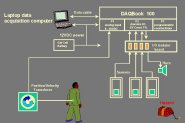 |
Block diagram of test data acquisition system. |
During the winter of 1996-97 a data acquisition system was developed and assembled to test sensors mounted on a tractor, generating performance data which can be analyzed statistically and examined for correlations to test conditions. For each set of conditions, two modes of testing were employed. Sensors were first tested both for the speed and reliability with which they detected a human moving into the protected area, and second, for susceptibility to false alarms.
The system allows for the use of multiple sensors simultaneously, and repetitive passes are used to generate statistical data on reliability. Using Boolean logic, it is possible to test various combinations of sensor outputs for effectiveness in minimizing false alarms (i.e. two or more sensors must go into an alarm condition before the overall multi-sensor system goes into an alarm condition).
The heart of the the test system consists of an IBM ThinkPad 486-100 laptop computer and an IOtech DaqBook100 data acquisition board connected to the parallel printer port. Test programs (Virtual Instruments) written using National Instruments LabVIEW communicate with the DaqBook, providing the operator interface panel and data storage to delimited text files. Solid state relays were used to protect the CMOS TTL discrete I/O ports of the DaqBook. Approach velocity and position of the human test subject were monitored using a PSI-TRONIX DVT-500 linear motion transducer. The system was powered by a pair of 12 volt lead/acid gel cell batteries and mounted on an IH 986 tractor.
Sensors were mounted on a rail along the rear of the tractor aimed toward areas that a person would cross through if approaching a rotating PTO shaft attached to an implement. To allow fast and easy changes in positioning and aiming, the rail is drilled on two inch centers and sensors are mounted using ballheads designed for use on camera tripods.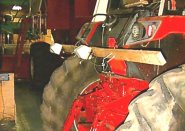 |
Sensor mounting rail on rear of tractor. |
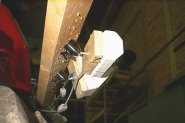 |
Sensors mounted using ballheads designed for use on camera tripods. |
In the tests reported in this paper, a Gehl self-unloading forage wagon was used as the PTO driven stationary implement. The zone to be protected included an envelope extending from the outer surfaces of the tractor's rear wheels extending from the rear surface of the tractor to the front face of the wagon. Figure below shows this configuration.
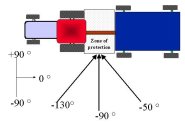 |
Diagram showing protected zone between tractor and wagon. |
As test subjects approached the potential hazard area, their velocity and position were recorded using a 500 inch linear motion transducer. This device consisted of a cable (attached to the person's belt) reeled from a spring-loaded drum coupled to a potentiometer and a DC generator, providing voltage outputs as a function of position and instantaneous velocity. Resolution of this system was limited by the analog input capabilities of the DAQBOOK to +/- 0.25 inches for position and +/- 0.1 inches per second for velocity.
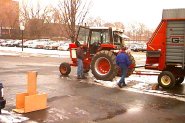 |
Test subject Ryan entering hazard area while trailing measurement cable (not visible) from position/velocity transducer at lower left |
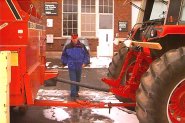 |
Ryan approaching hazard area. |
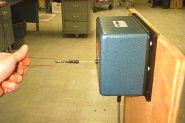 |
500 inch position/velocity transducer showing spring tensioned cable. |
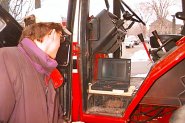 |
Jon operating data acquisition system |
Ten times per second, from the start of the pass until one second after detection, the software sampled the sensor status, the velocity and position of the test subject relative to the hazard, and warning time. The warning time was calculated by dividing the distance remaining between the approaching person and the hazard at the time of detection by their maximum velocity during the one-second preceding detection. This calculated time is important since it provides an indication of the amount of time available to respond to the signal (such as shut down or warning) before the human reaches the hazard. For each pass, at the moment of detection, the system latched the readings and logged them to a file which summarized the results of the entire test run. In addition, the system logged time-stamped raw data for all passes to a separate file for detailed examination if needed.
 |
Sample display screen . |
The first round of testing completed during summer 1997 focused using three different sensors individually to examine performance of sensors independently of one another.
A total of 822 subject approach passes were completed. With each sensor, test subjects approached at differing angles including perpendicular to power take-off shaft and at angles +/- 40 degrees from perpendicular. These three approach angles were repeated for two clothing styles including typical summer and winter wear. In these 822 passes, there were no sensor "misses." No false alarms occurred during the subject approach test passes.
Relatively few alarm events were generated during tests for false trigger susceptibility. As long as the tractor was not rolling over the ground, all three sensors were surprisingly immune to engine vibration, operator activity, PTO shaft rotation, and objects tossed through the protected area.
Clothing had little effect on sensor performance as can be seen in summary Table 2 which shows the distance from the hazard at the time of detection for varying clothing styles and angles for each of the three sensors tested. Note however, that the angle of approach has an impact on detector performance, probably due to differences in sensor field geometry.
| Table
2
Inches from Hazard |
|||||||
| Clothing Style | Light | Light | Light | Heavy | Heavy | Heavy | |
| Approach Angle | -50 | -90 | -130 | -50 | -90 | -130 | Average By Sensor across angles & clothing types |
| PIR | 41.6 | 30.1 | 32.5 | 39.8 | 35.2 | 29.6 | 34.8 |
| MW/PIR | 45.2 | 33.2 | 26.9 | 43.0 | 35.6 | 28.8 | 35.4 |
| MW/PRES | 33.9 | 52.4 | 45.6 | 32.1 | 47.7 | 43.1 | 42.5 |
| By angles&clothing across sensor types | 40.2 | 38.6 | 35.0 | 38.3 | 39.5 | 33.9 | |
| Readings for both clothing types averaged over sensors&angles | 37.9 | 37.2 |
Additional tests were performed in 1997 on configurations of multiple sensors in which various sensor outputs were logically ANDed, requiring all to trigger to generate an alarm event. In these modes the system performs very well, but detection performance is limited by the slowest acting sensor. It appears that when performance tests are conducted in ideal conditions such as those reported here, the added redundancy of multiple sensors might not be necessary to reduce false alarms.
Ongoing work:The system has been modified to allow relative timing, in addition to boolean combination, of the sensor outputs to be used as alarm criteria. More aggressive testing for false alarms is planned. Additional narrow field PIR and MW/PRES sensors have been acquired and are being tested. The most promising configurations use a wide field MW/PRES sensor on the tractor centerline with a a narrow field PIR or MW/PRES sensor on either side.
Summary and RecommendationsThis work represents an important first step toward the development of a human presence sensing system that may have potential for field applications. The two sensing technologies tested together provide the overlap necessary to significantly reduce false alarms and misses in agricultural work environments. However, additional research is needed to further develop and refine individual sensing components and housings to assure that they will withstand the environmental conditions and use that they would receive over the life of a typical machine.
Hopefully, additional work can be completed during the coming years in cooperation with universities, equipment manufacturers, and various public institutions and funding agencies with interests in helping producers protect themselves from the dangers of rotating equipment.
Funded in part through Midwest Center for Agricultural Research, Education, and Disease and Injury Prevention: A NIOSH/CDC Cooperative Agreement Program, #U07/CCU507126-07.
Thanks also to The National Farm Medicine Center, a department of Marshfield Medical Research and Education Foundation, a division of Marshfield Clinic in Marshfield, Wisconsin for their interest and support of this project.
Email comments to John Shutske or Bill Gilbert
John
Shutske, Associate Professor, Bill Gilbert, Assistant Scientist,
Jonathan Chaplin, Associate Professor, Paul Gunderson, Director,
National Farm Medicine Center, Marshfield, WI
Last updated March 31, 1998 © 1997 Regents of the University
of Minnesota. All Rights Reserved.
The University of Minnesota is an equal opportunity educator and employer.
This page is part of the Biosystems and Agricultural Engineering Department web at http://www.bbe.umn.edu/Disclaimer and Reproduction Information: Information in NASD does not represent NIOSH policy. Information included in NASD appears by permission of the author and/or copyright holder. More